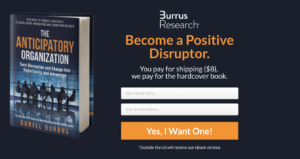Time Travel Audit: Find Success Now and in the Future
You don't need a DeLorean for time travel. For example, you can visit remote parts of the Amazon River and meet people who live just as they did a thousand years ago, using blowguns and spears as their current technology.
Even here in the U.S., you can visit Amish towns in Ohio and Pennsylvania, where people live just as they did merely a hundred years ago, getting their water from a well and using oil lanterns for light. For them, a horse and buggy is their Tesla Model X.
This same kind of time travel also occurs in business. You can time travel at organizations in your hometown that use legacy technology and antiquated techniques. These legacy systems may keep such businesses alive and well in the rapidly vanishing past, but surviving the present will become an impossible task.
Time travel is also possible between divisions within an organization. For example, the engineering department may be equipped with the latest technologies while HR is still using paper files and longhand forms. Today, you can even go from person to person and be time traveling, as some people are so past-oriented that the past is all that matters -- to them, and the future is foreboding and therefore inferior.
Fortunately, you can also travel to the future. The individuals in your organization who buy the latest gadgets with their own money in order to experiment with and learn from them are already living in the future.
Some organizations are more future-oriented than others, even in the same or related industries. For example, the manufacturing industry has moved into Industry 4.0, while its construction counterpart has been slower to adapt and change. And some leaders in every industry -- Apple being the most notable -- roll out products and services consumers never knew they wanted, yet find to be indispensable once they have them in hand.
This mindset is what I discuss in my bestselling book The Anticipatory Organization. By paying attention to Hard Trends that will happen, savvy organizations like Apple are able to become more anticipatory and to turn disruption and change into opportunity and advantage.
If you are ready to become an Anticipatory Leader at your organization and help lead it into the future, consider taking these three steps:
- Do a time travel audit of yourself and your colleagues. Where in time do you and your colleagues live? Who is future-oriented, present-oriented, or past-oriented -- and how are those outlooks serving the company? Remember, while you can look at the past and learn from it, it should not hold you back. Your windshield is larger than your rearview mirror for a reason. To drive safely, you need to keep your eyes focused on the big picture in front of you and only occasionally look back.
- Turn past thinkers into Anticipatory Leaders. Some people in your organization may be past-oriented and dread the future -- but their experience and wisdom are still incredibly valuable. You can either choose to let such people go and lose the valuable assets they possess or turn them into Anticipatory Leaders by placing them in roles that suit their personalities. Encourage them to enrich their perspectives by asking them what they believe is vital for the organization to keep as it moves forward in order to thrive. This question forces them to consider both the core capabilities that got the company to where it is today and the Hard Trends that are shaping the future of the industry. Overall, this approach positions your past thinkers strategically based on what they like doing and helps them become more anticipatory.
- Relate to others at their point in time. Do a time travel audit on the people you interact with. If you have a new product or service that is future-oriented but are talking to someone who is past-oriented, leading with your future perspective will frighten him or her. You can't force individuals into the future; you must transition them into the future. Relate to their position in the past; acknowledge why they are comforted by where they are, the technologies they use, and the principles they're working under. Help them understand the Hard Trends that are the undeniable truths about the future, and in this way walk them slowly into that future instead of trying to shove them into it. Remember that many people are naturally timid about stepping out of their comfort zone, so be careful not to place blame. You'll be more likely to succeed if you can help them see that change is the only constant and that we all must adapt in order to thrive.
The Future Is Yours
Years ago, it was possible to have a past or present mindset and still do quite well, because the pace of change was relatively slow. But now, technology is moving at the speed of light, transforming everything we've come to know. As an Anticipatory Leader, you must migrate your people and your organization to become anticipatory as well. Remember, time doesn't move in reverse; it is always moving forward. Help everyone in your organization to see the future, embrace it, and thrive in it to ensure long-term success.
Think about the actions you can take today to personally or professionally move toward the future.
To book Daniel Burrus for your next event, visit his profile at https://premierespeakers.com/daniel-burrus.
Burrus is the author of The Anticipatory Organization: Turn Disruption and Change into Opportunity and Advantage and Flash Foresight: How to See the Invisible and Do the Impossible. To order in bulk for your event, please visit Bulkbooks.com.
 The post Time Travel Audit: Find Success Now and in the Future appeared first on Daniel Burrus.
The post Time Travel Audit: Find Success Now and in the Future appeared first on Daniel Burrus.








